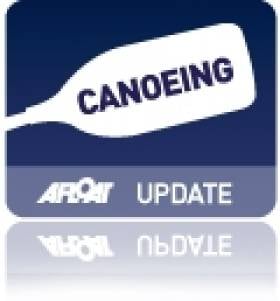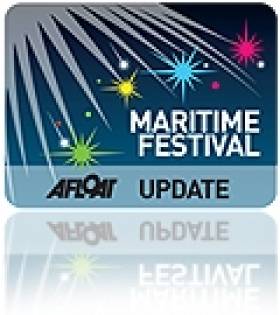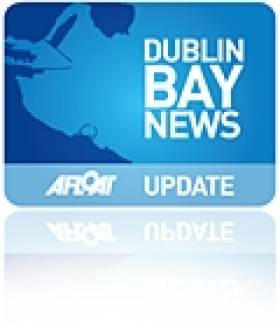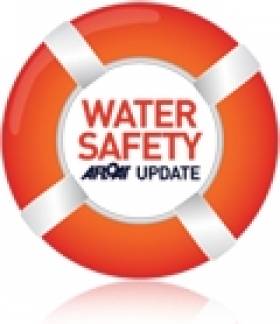Displaying items by tag: River Liffey
Dublin Port: As You’ve Never Seen It Before
On board the open-topped yellow tour-boat RIB, an audio commentary firstly informs you about the M.V. Cill Airne, built nearby in the old Liffey Dockyard, nearly fifty year ago. Discover why she was one of the last riveted built vessels in Europe, her days as liner-tender and the rich and famous who threaded her decks.
Heading downstream the former lightship Kittiwake is berthed opposite the O2 Arena. She was one of the last lightships to serve in Irish waters at the South Rock station off Co. Down. In complete contrast a ferris-wheel revolves in the background but no sooner the boat slips under the East-Link Toll-Lift bridge which opened in 1984.
On the other side of the bridge a small non-descript looking grey-hulled motorboat lies at anchor, on her bow is painted the figure 11. So what's the story here!...here's a glue: 'Don't pay the ferry man until you get to the other side!...
Past Poolbeg Marina, giant blue-gantries cranes of the Marine Terminal Ltd (MTL) are busy unloading from Karin Schepers, a containership previously reported on Afloat.ie. Look out for the ports 'graffiti', the work of crews who make their mark by painting the name of their ship and also the mural of the late Ronnie Drew of The Dubliners.
Opposite this terminal is the ports largest basin, Alexandra Basin, named after Queen Alexandra. Subject to port security, the tour may include entering the basin should there be a particular vessel of note.This also allows for views of the dock-gates of the Dublin Graving Dock, one of only three large ship-repair facilities on the island of Ireland. Neighbouring the graving dock is where the Liffey Dockyard once stood.
Before the tour passes the towering twin stacks of the former ESB Poolbeg electricity power station is tucked away Pigeon Harbour. Learn more about its hotel conveniently sited beside where packet-ships regularly plied, essentially the ferryport of its day. Its modern-day counterpart faces opposite on the north quays where up to 17 sailings daily operate on the Irish Sea.
Marvel at the length of the impressive Great South Wall, why was it called 'Great' and why was it built?... What can be revealed is that Captain William Bligh of "Mutiny of the Bounty" fame was a major figure in the project, when the wall was completed in 1795.
The commentary has many more fascinating facts, figures and the occasional anecdote told with typical Dublin wit. So if you live within 80km (50-mile) radius of the capital, then the chances that the shirt you wear, the breakfast cereal you ate and the car you drive, most likely came through Dublin Port as almost 75% of goods serve this hinterland.
More on Dublin Bay here
- Dublin Port
- River Lee
- Sea Safari Tours
- Poolbeg Marina
- River Liffey
- Ports and Shipping News
- ESB
- Karin Schepers
- EastLink bridge
- Dublin Port & River Liffey Tours
- Dublin ferryport
- MV Cill Airne
- ESB Poolbeg powerstation
- Alexandra Basin Dublin Port
- Liffey Dockyard
- Dublin Bay boat operator
- Marine Terminal Ltd
- MTL
Arthur's Day: Time to Reflect the Last Guinness Ships
The Lady Patricia represented the last of the more traditional Guinness vessels, though her predecessors The Lady Grania and The Lady Gwendolen differred in that they had split superstructures with the bridge admidships and accommodation quarters placed aft. Whereas The Lady Patricia had her superstructure positioned well aft.
In addition she was the last to carry a 'Lady' prefix name. She was named after the daughter of Lord Iveagh, Rupert Guinness, when entering service in 1962 from the yard of Charles Hill & Sons, Bristol. Her entry allowed the Guinness to be eventually replaced when she went to be scrapped at Faslane the following year.
Two deck-mounted granes that were used to hoist silver cylinders containing the beer where removed in 1973 from The Lady Patricia when she was converted into the world's first beer-tanker. The new method no longer required the cumbersome and time-consuming process of loading barrels from trucks. Instead trucks fitted with tanks transferred the liquid-cargo through pipes which involved pumped some 205,000 gallons or 1.87 million pints on board.
Unlike The Lady Patricia which was converted for tanker operations, the Miranda Guinness became the world's first custom-built beer-tanker when launched in 1976 from the Albion Shipyard also in Bristol. She also represented the last vessel to be launched (see PHOTO) there, after 156 years of shipbuilding.
Miranda Guinness was named by the Countess of Iveagh, after whom she was named. The newbuild replaced both The Lady Grania and The Lady Gwendolen which were sold. Since their launch The Lady Patricia and Miranda Guinness were registered in Liverpool until 1987 when the port of registry became Dublin. This arose following a change in the vessels management to Irish Marine Services Ltd, which was made up of former Irish Shipping Ltd management.
This arrangement only lasted to 1993 when Guinness discontinued the world's only beer-tanker shipping operation on the route linking Ireland and Britain. The process had allowed millions of pints to be served through the use of conveying the 'black-stuff' on board the dedicated beer-tankers or should that be those stout ships! Of the two vessels, the Miranda Guinness was the last to depart Dublin Port.
The ships were sold for scrapping on Merseyside and replaced in the form of 20-foot transportable tank trailers towed by trucks using Irish Sea ferry routes. Each of the silver tankers holds 10,000 gallons which is equivilant to 80,000 pints. It would take someone drinking 10 pints a day 22 years to drink it! Now that would be another challenge for the famous Guinness Book of Records!
In addition as we approach 17:59hrs, reflecting the 1759 date of the lease signing by Arthur Guinness, perhaps that minute could also be used to reflect a unique era in Irish brewing transportation methods and shipping history. By the way, Cheers to Arthur!
- River Liffey
- Ports and Shipping News
- Sir John Rogersons Quay
- Irish Shipping Ltd
- Guinness
- Guinness barges
- The Last Guinness Ships
- Arthur's Day
- The Lady Patricia
- Miranda Guinness
- Stout Ships
- Beer tankers
- Runcorn
- Manchester Ship Canal
- St. James Gate
- Stouttankers
- Charles Hiil & Sons Bristol
- Irish Marine Services Ltd
- Salford Docks
- Guinness concentrate
- Albion Shipyard Bristol
Small Is Beautiful as Cruiseships Call Closer to Capital
Clipper Odyssey is an unusual caller to the capital as she normally operates cruises in the Pacific Ocean from New Zealand to the Russian Far-East. As for Le Diamant she is a frequent caller not just to Dublin but throughout Irish ports during the season.
The Bahama-flagged 110-passenger Clipper Odyssey is scheduled to depart this evening around 21.45hrs. She is bound for Dunmore East with an lunchtime arrival off the Waterford fishing port. Le Diamant with a capacity for up to 226 passengers follows with a departure set for 23.00hrs and she is bound for Fishguard Harbour, the gateway to the scenic Pembrokeshire Coast National Park.
Currently only small cruiseships can dock within the 'Docklands' quarter quays due to the limitations imposed on dimensions, as vessels transit through the East-Link toll lift-bridge which was built in 1984. The majority of cruiseships, which are considerably larger and can exceed over 100,000 gross tonnes, berth 2kms downriver mostly in Alexandra Basin and adjoining Ocean Pier.
There are proposals to build a dedicated cruise-terminal close to the East-Link bridge on the far side at North Wall Quay Extension, which would allow such larger vessels to dock. This would facilitate easier access for cruise tourists to visit the attractions of the city-centre and indeed the nearby amenities of the O2 Arena, which would be within walking distance of the proposed cruise terminal.
- Dublin Port
- Dublin Docklands
- Sir John Rogerson's Quay
- Cruise Liners
- Cruiseships
- Sean O'Casey Bridge
- River Liffey
- Cruise Liner news
- Samuel Beckett Bridge
- Cruisecallers
- Le Diamant cruiseship
- Clipper Odyssey cruiseship
- Dublin GasWorks
- Dublin Gasometer
- Ringsend Gasworks
- Pembrokeshire Coast National Park
- O2 Arena
Liffey Descent Postponed Due To Lack of Water
The annual Liffey Descent canoe race has been pushed back by a month - due to a lack of water.
The Irish Canoe Union (ICU) announced that due to significantly low water levels in the ESB reservoirs that provide the flood for the race, the event has been postponed till 8 October.
Organisers said they were left with the "difficult decision" to either postpone the event or run the things as scheduled on 10 September without the flood.
“It is considered that the running of the race in the absence of the excitement generated by a flood would detract from its value as the premier Irish canoeing event," said a statement from the ICU.
The Liffey Swim has been an institution since 1960, atracting canoeists from around the world every September for the run from Kildare to Islandbridge.
The Irish Times has more on the story HERE.
Crosbie’s Café Lightship Plan Rejected
Dublin City Council told Crosbie that consent for the use of the campshires for the bar had not been agreed to by the board of the Dublin Dockland Development Authority (DDDA), which owns the quays, "and that said permission will not be forthcoming".
Crosbie had received a letter from the then chief executive officer of the DDDA Paul Maloney in December 2008 saying that the authority was willing to let the development go ahead, subject to consent from the authority's executive board.
This permission will not know be forthcoming but the authority does feel that the ship should be used as a bar on the Liffey itself rather than on the campshires.
The Kittiwake has laid idle since 2007 when the vessel was purchased from the Commissioners of Irish Lights. She was the second last lightship to serve in Irish waters. During the 1980's she and several other lightships were converted from manned operation into automatic light-floats or ALF's. To read more about the last Irish lightship ALF Gannet click HERE.
Up Close and Personal: New Boat Tours of Dublin Port
In addition to cruising this stretch of the River Liffey alongside the 'Docklands' quarter, the tour RIB boat will pass downriver through the East-Link toll bridge where visitors will get closer views of the variety of vessels and calling cruise liners from other ports throughout the world.
There will be five daily tours beginning at 10.00am, 12.00pm, 2.00pm, 4.00pm and 6.00pm.Tickets cost €15.00 for adults, €12.50 for students and the charge for senior citizens and children is €10.00.
In addition Sea Safari operate a 'River Liffey' only tour, a Dublin Bay 'North' and 'South' tours which visit Howth Head, Baily Lighthouse, Ireland's Eye and to Dalkey Island and Killiney Bay, where both bay tours provide a chance to spot local marine wildlife of seals, porpoises and sea birds.
- Rib
- Dublin Port
- Dublin Docklands
- Howth Head
- marine wildlife
- Cruise Liners
- Sea Safari Tours
- Dalkey Island
- Port of Dublin
- River Liffey
- Ports and Shipping News
- EastLink
- EastLink Toll Bridge
- Dublin Port news
- Baily Lighthouse
- Killiney Bay
- Seabirds
- Port of Dublin news
- RIBcraft
- M.V. Cill Airne
- Dublin Port cruise liners
- North Quay Wall Dublin
- Dublin Bay tours
- Ireland's Eye
Largest Vessel Transits Samuel Beckett Swing-Bridge
She remained alongside this berth which is normally used by large commercial ships until the vessel sought a berth much closer to the city-centre. This led to a shift of berths in the evening when the 2003 built vessel headed upriver to the Dublin City Moorings facility at Custom House Quay, but this firstly required transiting through two bridges.
With a beam of 10.6m Fortunate Sun entered through the East-Link toll-lift bridge followed by the Samuel Beckett bridge, the Liffey's newest crossing point which opened in late 2009. The €60m bridge was commissioned by Dublin City Council and designed by the Spanish architect engineer Santiago Calatrava. To read more on the bridge click HERE.
Fortunate Sun is registered in the Caymen Islands and is capable of over 17 knots on a range of 5000 nautical miles. She has a steel hull and an aluminium superstructure and interiors also by Tim Heywood Design. In the early hours of tomorrow morning the vessel built by Oceanfast is to depart through the 5,700 tonnes bridge which was delivered by barge after a five-day voyage from Rotterdam.
There has been previous transits of the bridge notably the annual Dublin Rally organised by the the Inland Waterways Association of Ireland (IWAI). This year's Dublin Rally took place on 1 May when boats travelling on the Royal Canal descended via Croke Park and entered the Liffey at Spencer Dock. This required the Iarnrod Éireann bridge-lift and the water level in Spencer Dock to be lowered so to allow safe clearance under the Sheriff St. bridge.
From there the IWAI flotilla made the short passage downriver to re-enter another inland waterway system at the Grand Canal Dock, marking where the Liffey connects with the city's southern canal. The 2011 Dublin Rally was the first time since 1955 that boats could enter Dublin from the Shannon via the Royal Canal and the first time since 2004 that boats also joined from the Royal Canal.
- powerboats
- motorboats
- inland waterways
- Dublin Port
- Dublin
- Grand Canal
- IWAI
- Royal Canal
- DDDA
- Inland Waterways Association of Ireland
- Dublin City Council
- Spencer Dock
- River Liffey
- Ports and Shipping News
- EastLink Toll Bridge
- Dublin Port news
- Grand Canal Dock
- Dublin Docklands Development Authority
- M.Y. Fortunate Sun
- Tim Heywood Design
- Lifffey
- Dublin City Moorings
- Custom House Dock
- Powerboat news
- Motoryachts
- Sir John Rogerson Quay
- Inland Waterways news
- Dublin Rally
- Ianrod Eireann
- Oceanfast
- Scottish Western Isles
Summer Festival in the Heart of Dublin’s ‘Docklands’
The Docklands Summer Festival takes place this weekend in Dublin's 'Docklands' and it is to host the Waterways Ireland Inter-County Sailing Championship, writes Jehan Ashmore.
Other events taking place on the River Liffey and throughout the docklands range from a Dragon Boat display in the Grand Canal Dock (outer basin) and a Boat Show (inner basin) see map. In addition the Waterways Ireland Visitor Centre will be open, noting all these activities and venues are to take place between 10am-6pm on Saturday.
On the following Sunday the Waterways Ireland Inter-County Sailing Championship Races are scheduled between 10am-4pm in the Grand Canal Dock's outer basin. City Canal Cruises will operate each day as well as an International Food Market, held in the Grand Canal Square, opposite the Grand Canal Theatre.
The pristinely kept M.V. Cill Airne, now a floating restaurant and bar will be open at her berth alongside North Wall Quay, close to the striking Samuel Beckett Bridge and The Convention Centre.
The historic veteran vessel built in Dublin at the Liffey Shipyard in the early 1960's was launched as a passenger tender to serve trans-Atlantic liners that called to Cobh. During her tender-duties she brought the rich and famous ashore to include Laurel & Hardy and US President Eisenhower.
The festival is sponsored by Waterways Ireland and the Docklands Business Forum. To see the full festival programme and a map of the docklands click HERE and www.ddda.ie
- Waterways Ireland
- Cobh
- DDDA
- Dublin Bay News
- Port of Dublin
- River Liffey
- Grand Canal Dock
- Docklands Summer Festival
- Dublin Docklands Development Authority
- Samuel Beckett Bridge
- The Convention Centre
- North Wall Quay
- City Canal Cruises
- Grand Canal Theatre
- M.V.Cill Airne
- Passenger Tender
- TransAtlantic Liners
- Laurel & Hardy
- President Eisenhower
- US President Eisenhower
- Dublin City
- Docklands Business Forum
- Dragon Boat Display
- Dragon's
- Dragon sailing boats
- Dragon craft
Lord Mayor to Preside over Old Gaffers' Parade of Sail
Dublin's Lord Mayor Gerry Breen will assume the traditional title of Admiral of the Port of Dublin when he presides over the Parade of Sail on the Liffey later this month.
The parade on Sunday 29 May is a highlight of the annual Dublin Bay Old Gaffers Association rally, which this year is held in tandem with the Stella Maris Rowing Club regatta.
Rowing clubs along the east coast will be sending crews to Dublin to compete for the special Asgard Trophy, which is made of timber used in the conservation of the original Asgard in the National Museum.
The event - centred at the Poolbeg Yacht and Boat Club near Ringsend - is also expected to attract classic vessels from ports in Wales and Northern Ireland.
For more information contact the Dublin Bay Old Gaffers Association at www.dublinbayoldgaffersassociation.com or [email protected]
The Old Gaffers Association is a sailing organisation dedicated to preserving traditional sailing craft, usually former working boats, and mainly of wooden construction, promoting their distinctive gaff rig.
Boy Drowns in Liffey, Diver Treated for Bends
Gardaí have confirmed that a 14-year-old boy drowned in the River Liffey near Clane, Co Kildare on Saturday.
According to The Irish Times, it is believed the accident occurred while the teen was playing in the river with friends. His body was removed to Naas hospital.
Elsewhere, RTÉ News reports that a diver is being treated for the bends after getting into difficulty in the sea near Kilkee, Co Clare on Sunday.
The man was airlifted by the Shannon coast guard to Galway's University Hospital after being retrieved by colleagues.







































































